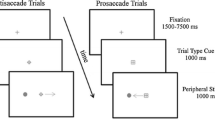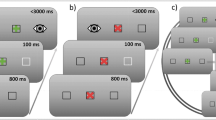Abstract
The ability to change behavior to adapt to the environment, known as behavioral plasticity, is an important part of daily life. In the present study subjects’ performances on antisaccade tasks were manipulated by training them on one of three different eye movement tasks (antisaccade, prosaccade, and fixation). Thirty subjects were tested at three time points over a 2-week period and practiced their assigned task every day between test sessions. Subjects who trained on antisaccades significantly decreased their error rates, while maintaining their reaction time, suggesting that accuracy did not improve at the expense of speed. Subjects who practiced the prosaccade task made more errors on the antisaccade task on subsequent test sessions, while those who practiced the fixation task showed no change across test sessions. These results suggest that deliberate practice of eye movement tasks can alter antisaccade performance, and that the direction of the effect is dependent upon the type of practice in which the subject engages.




Similar content being viewed by others
References
Anderson TJ, Jenkins IH, Brooks DJ, Hawken MB, Frackowiak RS, Kennard C (1994) Cortical control of saccades and fixation in man. A PET study. Brain 117:1073–1084
Braun D, Breitmeyer BG (1988) Relationship between directed visual attention and saccadic reaction times. Exp Brain Res 73:546–552
Ettinger U, Kumari V, Crawford TJ, Davis RE, Sharma T, Corr PJ (2003) Reliability of smooth pursuit, fixation, and saccadic eye movements. Psychophysiology 40:620–628
Everling S, Fischer B (1998) The antisaccade: a review of basic research and clinical studies. Neuropsychologia 36:885–899
Fischer B, Hartnegg K (2000) Effects of visual training on saccade control in dyslexia. Perception 29:531–542
Fischer B, Ramsperger E (1986) Human express saccades: effects of randomization and daily practice. Exp Brain Res 64:569–578
Fischer B, Weber H, Biscaldi M, Aiple F, Otto P, Stuhr V (1993) Separate populations of visually guided saccades in humans: reaction times and amplitudes. Exp Brain Res 92:528–541
Fischer B, Biscaldi M, Gezeck S (1997) On the development of voluntary and reflexive components in human saccade generation. Brain Res 754:285–297
Fischer B, Gezeck S, Hartnegg K (2000a) On the production and correction of involuntary prosaccades in a gap antisaccade task. Vision Res 40:2211–2217
Fischer B, Hartnegg K, Mokler A (2000b) Dynamic visual perception of dyslexic children. Perception 29:523–530
Fukushima J, Hatta T, Fukushima K (2000) Development of voluntary control of saccadic eye movements. I. Age-related changes in normal children. Brain Dev 22:173–180
Garavan H, Ross TJ, Stein EA (1999) Right hemispheric dominance of inhibitory control: an event-related functional MRI study. Proc Natl Acad Sci U S A 96:8301–8306
Jansma JM, Ramsey NF, Slagter HA, Kahn RS (2001) Functional anatomical correlates of controlled and automatic processing. J Cogn Neurosci 13:730–743
Karni A, Meyer G, Jezzard P, Adams MM, Turner R, Ungerleider LG (1995) Functional MRI evidence for adult motor cortex plasticity during motor skill learning. Nature 377:155–158
Kassubek J, Schmidtke K, Kimmig H, Lucking CH, Greenlee MW (2001) Changes in cortical activation during mirror reading before and after training: an fMRI study of procedural learning. Brain Res Cogn Brain Res 10:207–217
Klein C, Berg P (2001) Four-week test-retest stability of individual differences in the saccadic CNV, two saccadic task parameters, and selected neuropsychological tests. Psychophysiology 38:704–711
Klein C, Fischer B, Hartnegg K, Heiss WH, Roth M (2000) Optomotor and neuropsychological performance in old age. Exp Brain Res 135:141–154
Konishi S, Nakajima K, Uchida I, Kikyo H, Kameyama M, Miyashita Y (1999) Common inhibitory mechanism in human inferior prefrontal cortex revealed by event-related functional MRI. Brain 122:981–991
McDowell JE, Clementz BA (1997) The effect of fixation condition manipulations on antisaccade performance in schizophrenia: studies of diagnostic specificity. Exp Brain Res 115:333–344
McDowell JE, Brown GG, Paulus M, Martinez A, Stewart SE, Dubowitz DJ, Braff DL (2002) Neural correlates of refixation saccades and antisaccades in normal and schizophrenia subjects. Biol Psychiatry 51:216–223
Mount J (1996) Effect of practice of a throwing skill in one body position on performance of the skill in an alternate position. Percept Mot Skills 83:723–732
Munoz DP, Broughton JR, Goldring JE, Armstrong IT (1998) Age-related performance of human subjects on saccadic eye movement tasks. Exp Brain Res 121:391–400
O’Driscoll GA, Strakowski SM, Alpert NM, Matthysse SW, Rauch SL, Levy DL, Holzman PS (1998) Differences in cerebral activation during smooth pursuit and saccadic eye movements using positron-emission tomography. Biol Psychiatry 44:685–689
Opris I, Barborica A, Ferrera VP (2001) On the gap effect for saccades evoked by electrical microstimulation of frontal eye fields in monkeys. Exp Brain Res 138:1–7
Pierrot-Deseilligny C, Rivaud S, Gaymard B, Agid Y (1991) Cortical control of reflexive visually-guided saccades. Brain 114:1473–1485
Pierrot-Deseilligny C, Ploner CJ, Muri RM, Gaymard B, Rivaud-Pechoux S (2002) Effects of cortical lesions on saccadic: eye movements in humans. Ann N Y Acad Sci 956:216–229
Pierrot-Deseilligny C, Muri RM, Ploner CJ, Gaymard B, Demeret S, Rivaud-Pechoux S (2003) Decisional role of the dorsolateral prefrontal cortex in ocular motor behaviour. Brain 126:1460–1473
Poldrack RA, Desmond JE, Glover GH, Gabrieli JD (1998) The neural basis of visual skill learning: an fMRI study of mirror reading. Cereb Cortex 8:1–10
Roberts R, Hager, LS, & Heron, C (1994) Prefrontal cognitive processes: working memory and inhibition in the antisaccade task. J Exp Psychol Gen 123:374–393
Roy-Byrne P, Radant A, Wingerson D, Cowley DS (1995) Human oculomotor function: reliability and diurnal variation. Biol Psychiatry 38:92–97
Smyrnis N, Evdokimidis I, Stefanis NC, Constantinidis TS, Avramopoulos D, Theleritis C, Paximadis C, Efstratiadis C, Kastrinakis G, Stefanis CN (2002) The antisaccade task in a sample of 2:006 young males. II. Effects of task parameters. Exp Brain Res 147:53–63
Wenban-Smith MG, Findlay JM (1991) Express saccades: is there a separate population in humans? Exp Brain Res 87:218–222
Acknowledgements
This research was supported in part by a grant from the National Institute of Mental Health (MH01852). We thank Jamie Calhoun for her help in data collection and scoring.
Author information
Authors and Affiliations
Corresponding author
Rights and permissions
About this article
Cite this article
Dyckman, K.A., McDowell, J.E. Behavioral plasticity of antisaccade performance following daily practice. Exp Brain Res 162, 63–69 (2005). https://doi.org/10.1007/s00221-004-2105-9
Received:
Accepted:
Published:
Issue Date:
DOI: https://doi.org/10.1007/s00221-004-2105-9




